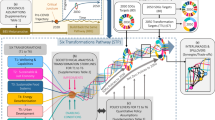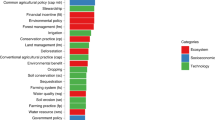Abstract
Sustainable Development Goal (SDG) 2 consists of five targets ranging from the eradication of hunger and malnutrition to doubling productivity of small-scale farmers and ensuring sustainable and resilient food production systems. Trade-offs and synergies arise between strategies to achieve any one of these targets, which complicates the use of evidence to guide policies and investments since most analyses focus solely on one objective. This gives rise to ‘blind spots’ in the evidence base, where acting to achieve one objective can have strong impacts on achieving others, hampering attempts to establish a systematic approach to attaining the multiple objectives of SDG 2. Here, we focus on three key blind spots that arise from potential interactions between increasing agricultural productivity and enhancing the sustainability of food production systems, eradicating hunger and malnutrition, and increasing the resilience of food production systems to climate change. Incorporating the consideration of synergies and trade-offs into policy-making is also essential; however, there is relatively little evidence of this occurring in national policies to date.
This is a preview of subscription content, access via your institution
Access options
Access Nature and 54 other Nature Portfolio journals
Get Nature+, our best-value online-access subscription
$29.99 / 30 days
cancel any time
Subscribe to this journal
Receive 12 digital issues and online access to articles
$119.00 per year
only $9.92 per issue
Buy this article
- Purchase on Springer Link
- Instant access to full article PDF
Prices may be subject to local taxes which are calculated during checkout
Similar content being viewed by others
References
Goal 2: Zero Hunger. United Nations https://www.un.org/sustainabledevelopment/hunger/ (2015).
Nutrition and Food Systems: A Report by the High Level Panel of Experts on Food Security and Nutrition (HLPE, 2017).
Béné, C. et al. When food systems meet sustainability — current narratives and implications for actions. World Dev. 113, 116–130 (2019).
Creating a Sustainable Food Future: A Menu of Solutions to Feed Nearly 10 Billion People by 2050 (World Resources Institute, 2019).
IPCC Summary for Policymakers. In Climate Change and Land: An IPCC Special Report on Climate Change, Desertification, Land Degradation, Sustainable Land Management, Food Security, and Greenhouse Gas Fluxes in Terrestrial Ecosystems (eds Shukla, P. R. et al.) (in the press, 2019).
Tilman, D. Global environmental impacts of agricultural expansion: the need for sustainable and efficient practices. Proc. Natl Acad. Sci. USA 96, 5995–6000 (1999).
The State of the World’s Land and Water Resources for Food and Agriculture: Managing Systems at Risk (FAO, 2011).
Foley, J. A. et al. Global consequences of land use. Science 309, 570–574 (2005).
Foley, J. A. et al. Solutions for a cultivated planet. Nature 478, 337–342 (2011).
Coomes, O. T., Barham, B. L., MacDonald, G. K., Ramankutty, N. & Chavas, J. Leveraging total factor productivity growth for sustainable and resilient farming. Nat. Sustain. 2, 22–28 (2019).
The State of Food and Agriculture Report: Innovation in Family Farming (FAO, 2014).
Byerlee, D. & Murgai, R. Sense and sustainability revisited: the limits of total factor productivity measures of sustainable agricultural systems. Agric. Econ. 26, 227–236 (2001).
Fuglie, K. Is agricultural productivity growth slowing? Glob. Food Sec. 17, 73–83 (2018).
Cui, Z. et al. Pursuing sustainable productivity with millions of smallholder farmers. Nature 555, 363–366 (2018).
Díaz, S. et al. (eds) Summary for Policymakers: The Global Assessment Report on Biodiversity and Ecosystem Services (IPBES, 2019).
Tilman, D. In Agricultural Resilience: Perspectives from Ecology and Economics (eds Gardner, S. et al.) 39–59 (Cambridge University Press, 2018).
Renard, D. & Tilman, D. National food production stabilized by crop diversity. Nature 571, 257–260 (2019).
Power, A. Review of ecosystem services and agriculture: trade-offs and synergies. Philos. Trans. R. Soc. B 365, 2959–2971 (2010).
Panagos, P. et al. Cost of agricultural productivity loss due to soil erosion in the European Union: from direct cost evaluation approaches to the use of macroeconomic models. Land Degrad. Dev. 29, 383–859 (2018).
Pingali, P. Green Revolution: impacts, limits, and the path ahead. Proc. Natl Acad. Sci. USA 109, 12302–12308 (2012).
Evenson, R. E. & Gollin, D. Assessing the impact of the Green Revolution, 1960 to 2000. Science 300, 758–762 (2003).
Pandey, V. L., Mahendra, D. S. & Jayachandran, U. Impact of agricultural interventions on the nutritional status in South Asia: a review. Food Policy 62, 28–40 (2016).
Gómez, M. et al. Post-green revolution food systems and the triple burden of malnutrition. Food Policy 42, 129–138 (2013).
DeFries, R. Trade-offs and synergies among climate resilience, human nutrition and agricultural productivity of cereals — what are the implications for the agricultural research agenda? In Science Forum 2018 (Independent Science and Partnership Council, 2018).
DeFries, R. et al. Metrics for land-scarce agriculture: nutrient content must be better integrated into planning. Science 349, 238–240 (2015).
Benton, T. & Bailey, R. The paradox of productivity: agricultural productivity promotes food system inefficiency. Glob. Sustain. 2, E6 (2019).
Willett, W. et al. Food in the Anthropocene: the EAT–Lancet Commission on healthy diets from sustainable food systems. Lancet 393, 447–492 (2019).
Ray, D. K. et al. Climate change has likely already affected global food production. PLoS ONE 14, e0217148 (2019).
Rosenzweig, C. et al. Assessing agricultural risks of climate change in the 21st century in a global gridded crop model intercomparison. Proc. Natl Acad. Sci. USA 111, 3268–3273 (2014).
Burke, M., Dykema, J., Lobell, D. B., Miguel, E. & Satyanath, S. Incorporating climate uncertainty into estimates of climate change impacts. Rev. Econ. Stat. 97, 461–471 (2015).
Reynolds, M. et al. An integrated approach to maintaining cereal productivity under climate change. Glob. Food Secur. 8, 9–19 (2016).
Kanter, D. R. et al. Evaluating agricultural trade-offs in the age of sustainable development. Agric. Syst. 163, 73–88 (2018).
Antle, J. M. et al. Toward a new generation of agricultural system data, models, and knowledge products: state of agricultural systems science. Agric. Syst. 155, 255–268 (2017).
Sridharan, V. et al. The climate–land–energy–water nexus: implications for agricultural research. In Science Forum 2018 (Independent Science and Partnership Council, 2018).
Laborde, D., Debucquet, D., Bizikova, L., Lallemant, T. & Smaller, C. Ending Hunger: What Would it Cost? (IISD, 2016).
Prakash, A. (ed) Safeguarding Food Security in Volatile Global Markets 543–569 (FAO, 2011).
Bellu, L. G., Mueller, M. & Kavallari, A. Achieving Zero Hunger: The Critical Role of Investments in Social Protection and Agriculture (FAO, 2015).
Laborde, D. & Piñeiro, V. Monitoring agricultural productivity for sustainable production and R&D planning. Econ.: Open-Access, Open-Assess. E-J. 12, 1–11 (2018).
IAEG-SDGs: tier classification for global SDG indicators. United Nations https://unstats.un.org/sdgs/iaeg-sdgs/tier-classification/ (2020).
NDC Registry (Interim) (UNFCCC, 2020); https://www4.unfccc.int/sites/NDCStaging/Pages/All.aspx
Wood, S., Smith, M., Fanzo, J., Remans, R. & DeFries, R. Trade and the equitability of global food nutrient distribution. Nat. Sustain. 1, 34–37 (2018).
Longvah, T (ed.) Indian Food Composition Tables (National Institute of Nutrition, 2017).
Composition of Foods Raw, Processed, Prepared: USDA National Nutrient Database for Standard Reference, Release 27 (Agricultural Research Service, 2015); https://catalog.data.gov/dataset/composition-of-foods-raw-processed-prepared-usda-national-nutrient-database-for-standard-r.
Acknowledgements
We thank J. Porciello and S. Murphy for insightful discussions on the framing of the paper and the Independent Science and Partnership Council of the CGIAR for supporting the early work underlying some analysis in the manuscript. This work was supported by the Ceres 2030 project.
Author information
Authors and Affiliations
Contributions
L.L. conceived the idea and led in writing the paper. R.D. and L.B. contributed analysis and text for sections of the paper. All authors contributed to the narrative and writing of the paper.
Corresponding author
Ethics declarations
Competing interests
The authors declare no competing interests.
Additional information
Publisher’s note Springer Nature remains neutral with regard to jurisdictional claims in published maps and institutional affiliations.
Rights and permissions
About this article
Cite this article
Lipper, L., DeFries, R. & Bizikova, L. Shedding light on the evidence blind spots confounding the multiple objectives of SDG 2. Nat. Plants 6, 1203–1210 (2020). https://doi.org/10.1038/s41477-020-00792-y
Received:
Accepted:
Published:
Issue Date:
DOI: https://doi.org/10.1038/s41477-020-00792-y
This article is cited by
-
A scoping review on tools and methods for trait prioritization in crop breeding programmes
Nature Plants (2024)
-
Feast and famine in agricultural research
Nature Plants (2020)



